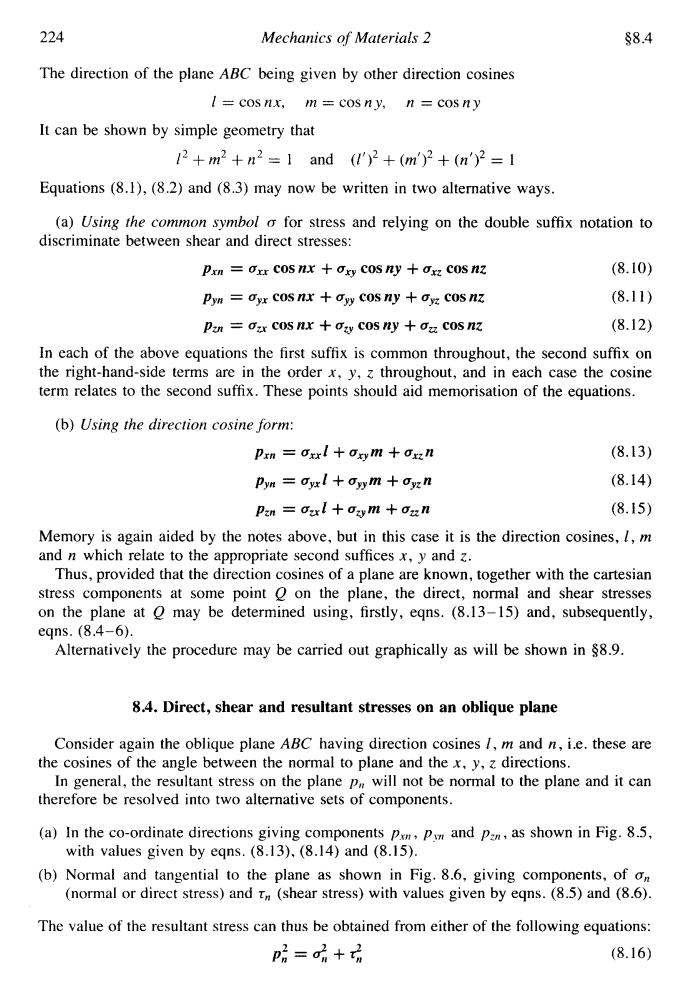正在加载图片...

224 Mechanics of Materials 2 $8.4 The direction of the plane ABC being given by other direction cosines I cos nx,m cos ny,n cos ny It can be shown by simple geometry that 2+m2+n2=1and('2+(m)2+(n')2=1 Equations (8.1),(8.2)and (8.3)may now be written in two alternative ways. (a)Using the common symbol o for stress and relying on the double suffix notation to discriminate between shear and direct stresses: Pxn =Oxx cos nx Oxy cos ny +oxz cos nz (8.10) Pyn dyx cos nx oyy cos ny +oyz cos nz (8.11) Pan =xx cos nx oxy cos ny +oz cos nz (8.12) In each of the above equations the first suffix is common throughout,the second suffix on the right-hand-side terms are in the order x,y,z throughout,and in each case the cosine term relates to the second suffix.These points should aid memorisation of the equations. (b)Using the direction cosine form: Prm=oxxl+Oym+ox红n (8.13) Pyn dyxl +oyym oyzn (8.14) Pin Oul ogym +oun (8.15) Memory is again aided by the notes above,but in this case it is the direction cosines,l,m and n which relate to the appropriate second suffices x,y and z. Thus,provided that the direction cosines of a plane are known,together with the cartesian stress components at some point o on the plane,the direct,normal and shear stresses on the plane at o may be determined using,firstly,eqns.(8.13-15)and,subsequently, eqns.(8.4-6). Alternatively the procedure may be carried out graphically as will be shown in $8.9. 8.4.Direct,shear and resultant stresses on an oblique plane Consider again the oblique plane ABC having direction cosines /m and n,i.e.these are the cosines of the angle between the normal to plane and the x,y,z directions. In general,the resultant stress on the plane p will not be normal to the plane and it can therefore be resolved into two alternative sets of components. (a)In the co-ordinate directions giving components px P and pn,as shown in Fig.8.5, with values given by eqns.(8.13).(8.14)and (8.15). (b)Normal and tangential to the plane as shown in Fig.8.6.giving components,of on (normal or direct stress)and n(shear stress)with values given by eqns.(8.5)and (8.6). The value of the resultant stress can thus be obtained from either of the following equations: p后=品+品 (8.16)224 Mechanics of Materials 2 88.4 The direction of the plane ABC being given by other direction cosines I = cosnx, tn = cosny, n = cosny It can be shown by simple geometry that l2 + m2 + n2 = 1 and (l’)’ + (m’)2 + (n’)* = 1 Equations (8.1), (8.2) and (8.3) may now be written in two alternative ways. (a) Using the cummon symbol cr for stress and relying on the double suffix notation to pxn = axx cos nx + uxy cos ny + axz cos nz (8. IO) pYn = uyx cos nx + ayy cos ny + uyz cos nz (8.1 1) pm = a, cos nx + azy cos ny + a, cos nz (8.12) In each of the above equations the first suffix is common throughout, the second suffix on the right-hand-side terms are in the order x, y, z throughout, and in each case the cosine term relates to the second suffix. These points should aid memorisation of the equations. discriminate between shear and direct stresses: (b) Using the direction cosine form: Pxn = uxxl + uxym + axzn pyn = uyxl+ uyym + uyzn pzn = uzrl + u,m + u,n (8.13) (8.14) (8. IS) Memory is again aided by the notes above, but in this case it is the direction cosines, 1, rn and n which relate to the appropriate second suffices x, y and z. Thus, provided that the direction cosines of a plane are known, together with the Cartesian stress components at some point Q on the plane, the direct, normal and shear stresses on the plane at Q may be determined using, firstly, eqns. (8.13-15) and, subsequently, eqns. (8.4-6). Alternatively the procedure may be carried out graphically as will be shown in $8.9. 8.4. Direct, shear and resultant stresses on an oblique plane Consider again the oblique plane ABC having direction cosines I, m and n, i.e. these are In general, the resultant stress on the plane pII will not be normal to the plane and it can the cosines of the angle between the normal to plane and the x, y. z directions. therefore be resolved into two alternative sets of Components. (a) In the co-ordinate directions giving components pI,, , pyn and p:,, , as shown in Fig. 8.5, with values given by eqns. (8.13), (8.14) and (8.15). (b) Normal and tangential to the plane as shown in Fig. 8.6, giving components, of a,, (normal or direct stress) and r,, (shear stress) with values given by eqns. (8.5) and (8.6). The value of the resultant stress can thus be obtained from either of the following equations: p,Z=d+d (8.16)